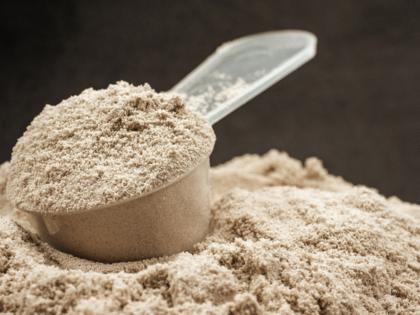Lisa Jarvis: Your protein powder isn't poisoning you
Published in Op Eds
Don’t toss out your protein powder just yet.
A recent report about lead levels in protein supplements sparked unnecessary alarm about a product that an increasing number of Americans are using to meet their fitness and nutrition goals.
The alarm is largely overblown. But the strong public reaction to what was once a niche product should cause us to take a beat and ask whether our growing protein obsession is healthy.
Let’s start with the study that triggered the panic. Consumer Reports said it tested 23 products, and two-thirds of the protein powders and shakes it analyzed contained more lead in a single serving than its experts said should be consumed in a day. Four products contained 400-1,500% of that amount.
But here’s the problem: The consumer advocacy group used the exposure limit established by California’s Proposition 65, which arbitrarily set 0.5 micrograms of lead as its daily limit decades ago. The Food and Drug Administration, meanwhile, sets limits that are orders of magnitude higher — 2.2 micrograms per day for children and 8.8 micrograms per day for women of childbearing age.
“Had they used the FDA levels in their analysis, they would have come up with a drastically different, way less fear-based report,” says Lauren Colenso-Semple, a muscle physiology researcher.
Even the product that caused the most concern should carry an asterisk. Naked Nutrition’s Vegan Mass Gainer, which Consumer Reports said had about 1,600% of its — again, artificially low — lead level of concern, has a serving size of six scoops that pack a whopping 1,230 calories, Colenso-Semple notes. By contrast, typical protein powders typically have a serving size of a single scoop, containing 100-150 calories. In other words, the loudest alarm bells are ringing for a niche product intended for weight gain — one she doubts most people actually use.
For the vast majority of users, consuming typical protein powders in reasonable amounts poses little to no risk. Perhaps, then, the more germane question raised by the Consumer Reports study isn’t whether protein powders are safe, but whether most of us truly need them in the first place.
As I’ve written, protein is definitely having a moment. Everyone is suddenly obsessed with cramming in extra protein throughout their day — whether that’s through powders, shakes, Greek yogurt, Starbucks lattes, protein-enriched Pop-Tarts, or, heaven forbid, a chicken smoothie.
It’s getting to be a bit much.
Whenever someone asks, “How much protein should I eat?” the answer depends on what they’re looking for from their diet, says Daniel Moore, a professor of muscle physiology at the University of Toronto. When it comes to staving off disease, the current recommended daily amount of about 0.8 grams per kilogram (roughly 54 grams per day for someone weighing 150 pounds) is sufficient for most people, he says. Data from the Centers for Disease Control and Prevention show that most Americans already exceed that benchmark with their regular diet. (The typical cooked chicken breast you might have for lunch or dinner contains about 30 grams of protein.)
Nutrition experts generally agree that these requirements should be somewhat higher for anyone who is active, especially endurance athletes or individuals hitting an age where muscle loss becomes a concern. And people taking obesity drugs like Wegovy and Zepbound, which can cause muscle mass to decline as the pounds come off, might also benefit from focusing more of their calories on protein.
Most of us need only a modest increase, depending on someone’s activity level and fitness goals. That means consuming about 1 to 1.6 grams of protein per kilogram per day, Moore says. Beyond that, however, the benefits become questionable. “Protein is the building block for muscle growth, and some people think, ‘Well, (if) some is good, more is better,’” he says. The research is mixed on whether the high protein intake some fitness influencers advocate is necessary or even helpful, he adds.
And since many of us can easily get adequate amounts from what we’re already eating, we should be mindful of where the quest for more protein can lead us astray. Big Food has been quick to capitalize on the public’s craving by introducing new versions of its popular products, boasting extra protein, tapping into a market projected to reach more than $100 billion in 2030, up from $67 billion in 2023, according to Grand View Research.
The problem is that few of those “protein-upgrades” offer meaningful nutritional value. Any consumer who picks up a snack food with the word “protein” in bold letters splashed across the label should look closely at how many grams it actually provides (usually far too little to make a real difference) and how that compares to its total calories and sugar, Colenso-Semple says.
To state the obvious: a Pop-Tart with extra protein is still a Pop-Tart. The same goes for Doritos with protein or any of the other junk food brands out there hoping the protein imprimatur will convince you their products are healthy — or even less unhealthy.
In the end, most of what we need should come from whole, nutrient-dense foods. Anyone struggling to squeeze enough protein into their day should consider snacks that offer a healthy boost, such as hard-boiled eggs, Greek yogurt, cottage cheese, and lean meats like chicken and pork.
And if healthy snacking isn’t always feasible (or, if like me, you can only eat so much cottage cheese in one lifetime), protein powders are a reasonable option — one that fear-mongering reports shouldn’t scare you into throwing away.
_____
This column reflects the personal views of the author and does not necessarily reflect the opinion of the editorial board or Bloomberg LP and its owners.
Lisa Jarvis is a Bloomberg Opinion columnist covering biotech, health care and the pharmaceutical industry. Previously, she was executive editor of Chemical & Engineering News.
_____
©2025 Bloomberg L.P. Visit bloomberg.com/opinion. Distributed by Tribune Content Agency, LLC.
























































Comments